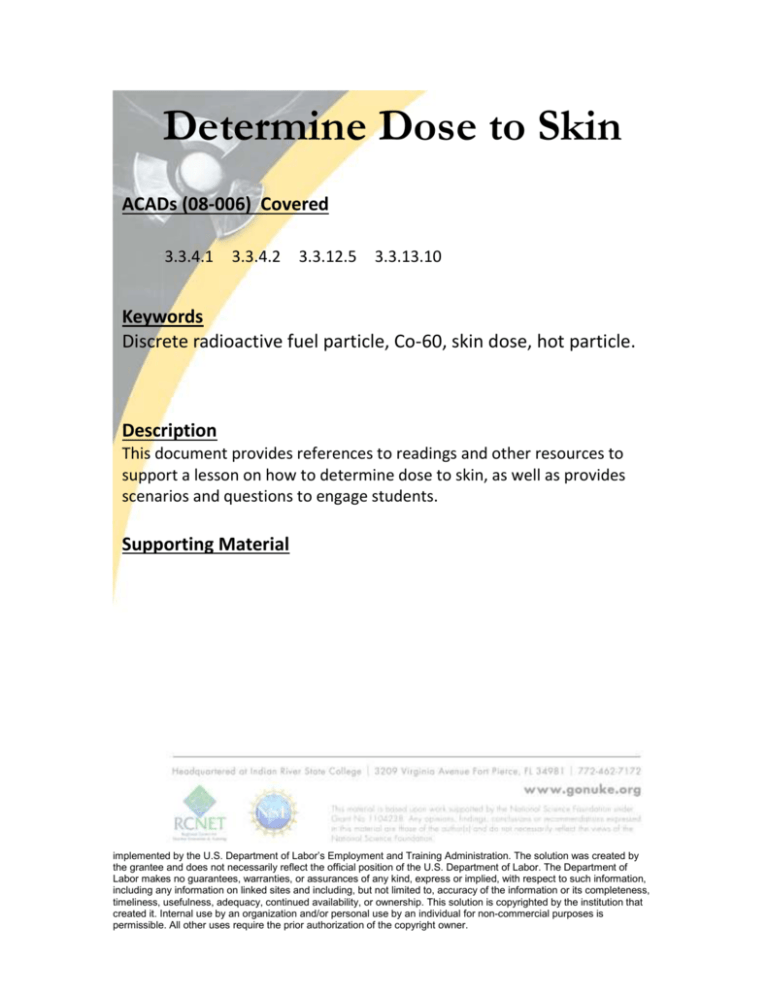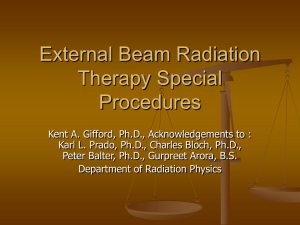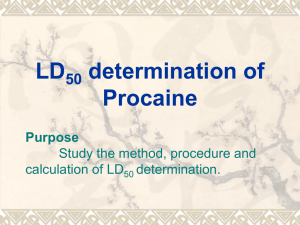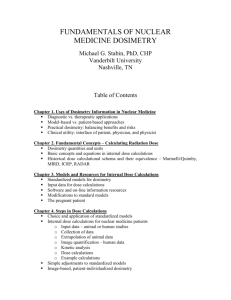
Determine Dose to Skin
ACADs (08-006) Covered
3.3.4.1
3.3.4.2
3.3.12.5
3.3.13.10
Keywords
Discrete radioactive fuel particle, Co-60, skin dose, hot particle.
Description
This document provides references to readings and other resources to
support a lesson on how to determine dose to skin, as well as provides
scenarios and questions to engage students.
Supporting Material
Copyright © 2008-2009 - Curators of the University of Missouri, in collaboration with Linn
State Technical College. All rights reserved. DMCA and other copyright information.
This workforce solution was funded by a grant awarded under the President’s High-Growth Job Training Grants as
implemented by the U.S. Department of Labor’s Employment and Training Administration. The solution was created by
the grantee and does not necessarily reflect the official position of the U.S. Department of Labor. The Department of
Labor makes no guarantees, warranties, or assurances of any kind, express or implied, with respect to such information,
including any information on linked sites and including, but not limited to, accuracy of the information or its completeness,
timeliness, usefulness, adequacy, continued availability, or ownership. This solution is copyrighted by the institution that
created it. Internal use by an organization and/or personal use by an individual for non-commercial purposes is
permissible. All other uses require the prior authorization of the copyright owner.
RPT 223
Instructional Resources
Module 9: Determine Dose to the Skin
Table of Contents:
Resources Key .................................................................................................................... 2
Module Readings and Homework ...................................................................................... 2
Primary Scenario “Determine Dose to the Skin from an Exposure to a Discrete
Radioactive Fuel Particle” .............................................................................................. 2
Transfer Scenario “Determine Dose to the Skin from an Exposure to a Discrete
Radioactive Particle of Co-60” ....................................................................................... 2
Module Assessment Items .................................................................................................. 3
Primary Scenario “Determine Dose to the Skin from an Exposure to a Discrete
Radioactive Fuel Particle” .............................................................................................. 3
ACAD References .............................................................................................................. 5
Module 9 Determine Dose to the Skin
The Curators of the University of Missouri
Copyright © 2008-2009
A Product of DOL Grant # HG-15355-06-60
Page 1
RPT 223
Instructional Resources
Resources Key
This refers This reference:
to:
ACAD
National Academy for Nuclear Training, Uniform Curriculum Guide for
Nuclear Power Plant Technician, Maintenance, and Nonlicensed
Operations Personnel Associate Degree Programs, ACAD 08-006.
DOE-SG
Office of Environmental, Safety and Health: Radiological Control
Technician Training Site Academic Training Study Guide Phase I,
Project Number TRNG-0003
G.
Available at: http://nsedu.rnet.missouri.edu/docshare/. File is located
under the Docs/General Curriculum/DOE materials folder.
Gollnick, D. (2006). Basic Radiation Protection Technology, 5th Ed.
Pacific Radiation Corporation, Altadena, CA.
Module Readings and Homework
Primary Scenario “Determine Dose to the Skin from an Exposure
to a Discrete Radioactive Fuel Particle”
Core Concept: Radiation interactions with tissue
Homework (end of chapter)
Calculation Items
Non-calculation Items
G. Chap 4, page 88, sample
G. Chap 4, page 86,
problem 2
sample problem 1
G. Chap 4, # 2, 4
Core Concept: Radio-sensitivity of cells
Homework (end of chapter)
Readings
Calculation Items
Non-calculation Items
G. Chap 4, 90-92
G. Chap 4, # 6, 8
DOE-SG-Mod 1.08-7 to 1.08-8
Readings
G. Chap 4, 83-92
DOE-SG-Mod 1.08-3 to 1.08-7
Core Concept: Skin dose
Readings
G. Chap 5, 146-148
Homework (end of chapter)
Calculation Items
Non-calculation Items
G. Chap 5, page 148, sample G. Chap 8, # 21
problem 8
G. Chap A-2, 810-815
G. Chap 5, # 9
Transfer Scenario “Determine Dose to the Skin from an
Exposure to a Discrete Radioactive Particle of Co-60”
Refer to readings and homework for primary scenario above.
RPT 223 Instructor’s Guide
The Curators of the University of Missouri
Copyright © 2008-2009
A Product of DOL Grant # HG-15355-06-60
Page 2
RPT 223
Instructional Resources
Module Assessment Items
Note: If instructors wish to increase the difficulty of any item, then we suggest
you use it as the basis for an in-class discussion, and / or require students to
write an explanation for why a particular choice is correct.
Primary Scenario “Determine Dose to the Skin from an Exposure
to a Discrete Radioactive Fuel Particle”
1. What characteristics do all discrete radioactive particle (DRP) have? Select ALL
that are correct.
a. Low levels of radioactivity
b. Microscopic in size CORRECT
c. Large alpha decay component
d. High energy gamma emission
e. Beta emissions CORRECT
f. Highly charged particle CORRECT
g. Exposes large areas of skin
2. A radiation worker has contamination on the outside surface of his worker’s glove
from a discrete hot particle. What would you do in assigning skin dose?
a. The skin dose can be assumed to be negligible due to glove attenuation
b. The skin dose can’t be calculated and must be estimated
c. The skin dose should be calculated assuming the glove is not present
d. The skin dose can be calculated based upon radiation attenuation by the
glove. (CORRECT)
3. Why did you choose the response above for assigning skin dose?
Select ALL that apply.
a. The number of beta particles reaching the skin will decrease (CORRECT)
b. There will be little effect on the skin dose because the gamma-rays will
easily penetrate the glove.
c. The energy of the beta particles will be reduced from attenuation through
the glove (CORRECT)
d. The thickness of a glove will stop all beta particles from a discrete hot
particle.
4. You have been asked to develop a new computer program to calculate dose to the
skin from skin contamination. What are some of the parameters that will be
needed in your code to calculate dose? Select ALL that apply.
a. The gamma-ray exposure coefficient for calculating dose from gammarays
b. The range of beta particles CORRECT
c. The penetration ability of alpha particles
Module 9 Determine Dose to the Skin
The Curators of the University of Missouri
Copyright © 2008-2009
A Product of DOL Grant # HG-15355-06-60
Page 3
RPT 223
Instructional Resources
d.
e.
f.
g.
h.
The dose as a function of depth in skin CORRECT
The types of cells in the skin receiving the dose.
The amount of clothing between the hot particle and the skin CORRECT
The distance a hot particle is from the skin CORRECT
The energy of beta particles CORRECT
5. Why is it important to know the energy of beta particles coming from the DRP to
accurately assess skin dose? Select ALL that apply.
a. The energy is important to calculating the amount of dose delivered as a
function of depth in skin. (CORRECT)
b. The energy is needed to determine if the beta particles can penetrate any
clothing covering the skin. (CORRECT)
c. The energy is likely to be monoenergetic, so the precise depth of
penetration of the beta particles can be calculated.
d. The energy remaining in the beta particles as they pass through the basal
layer is needed to calculate dose. (CORRECT)
6. A new model has been developed to predict the amount of energy deposited in the
basal layer of skin from a hot particle. This calculation estimates 10-8 J of energy
deposited in a 1 cm2 area over the basal layer depth of 0.002 cm. Assume a tissue
density of 1 gm/cm3. What is the dose to the skin in Gy and Rads?
Answer – Recall, dose is defined as energy deposited per unit of mass.
Volume of skin exposed = 1 cm2 x 0.002 cm = 0.002 cm3
Mass of skin exposed = 0.002 cm3 * 1 gm/cm3 = 0.002 gm = 2 x 10-6 kg
Dose = energy/mass = 10-8 J / 2 x 10-6 kg = 0.05 J/kg * 1 Gy/(J/kg) = 0.05
Gy
Dose = 0.05 Gy * 100 Rads/Gy = 5 Rad
7. Rate the following cell types from most to least radiosensitive.
Cell Type:
Skin cells
Fetal tissue
Bone
Nerves
Blood cells
Answer:
Skin cells
Fetal tissue
Bone
Nerves
Blood cells
Rate from most (1) to least (5)
radiosensitive:
3
1
4
5
2
RPT 223 Instructor’s Guide
The Curators of the University of Missouri
Copyright © 2008-2009
A Product of DOL Grant # HG-15355-06-60
Page 4
RPT 223
Instructional Resources
ACAD References
ACAD
3.3.4 BIOLOGICAL EFFECTS AND RISKS ASSOCIATED WITH
EXPOSURE TO IONIZING RADIATION
Describe the mechanisms of radiation interactions with cells (primary,
secondary/free radicals).
Identify cell characteristics that affect radiosensitivity (cells with a
longer dividing future, division rate and cell type).
3.3.12 RADIOLOGICAL INCIDENT EVALUATION AND CONTROL
Describe how to estimate skin dose resulting from skin contamination
including hot particles.
3.3.13 DECONTAMINATION
Identify conditions in which skin dose calculations should be performed
as a result of skin contamination.
Module 9 Determine Dose to the Skin
The Curators of the University of Missouri
Copyright © 2008-2009
A Product of DOL Grant # HG-15355-06-60
Page 5









